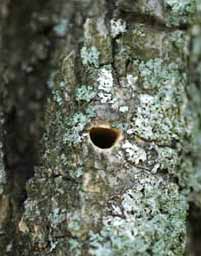What can I do to save my ash?
September 30th, 2010
The dreaded emerald ash borer officially arrived in Cumberland County this summer, and it probably is already throughout the Harrisburg area – or will be soon.
That bodes dreadful for Pennsylvania’s 3 million ash trees, including many in our parks, along our streets and in our yards.
The emerald ash borer is the latest imported killer bug that spreads quickly, has no natural U.S. enemy and can destroy even a large, healthy ash tree in 2 to 4 years.
Foresters, arborists and bug experts alike say this borer has the catastrophic potential to do to ash what disease did to American chestnuts and American elms – i.e. nearly wipe them off the map.
Ironically, many communities planted ash trees after their elms died.
What is this bug? Where did it come from?
The adult emerald ash borer is a metallic-green bug about the size of an elongated house fly.
It’s native to Asia and hitched a ride here in wooden packing material.
It first showed up in Michigan in 2002 and has spread to at least 10 states. It’s been moving eastward from Allegheny County since 2007.
What damage does it do?
Adult females lay eggs on the bark of ash trees. The skinny white caterpillar-like larvae that hatch bore into the tree and feed on the water- and nutrient-moving cells of the wood.
That destruction causes dieback of the branches, usually near the top first. A year or two later, the whole tree typically fails. Then you’ve got a hazard tree on your hands that could fall at any time.
The good news (if there is any) is that emerald ash borers attack only ash (the genus Fraxinus) and not maples, oaks, dogwoods, etc.
How concerned should I be?
Odds are good the borers eventually will find most ash trees. If/when they find yours, they’ll kill it unless you protect it.
Sven-Erik Spichiger, entomology program manager at the state Department of Agriculture, says a bigger threat is forest ash. “This has the potential to wipe out the entire genus,” he says.
A dozen species of ash make up about 6 percent of U.S. forests and account for a $20 billion chunk of the economy, primarily in logging (furniture, tools, baseball bats) and the nursery and landscaping industries.
What should I do?
“Job No. 1 is to determine that what you have really is ash,” says Hampden Twp. arborist Bob Carey, host of the Sunday-morning “Garden Talk” radio program on WIOO AM-1000.
He says people and even pros often mistake ash with European mountain ash (not a true ash), boxelders and walnuts.
An excellent resource with comparative pictures and identifying traits is at www.emeraldashborer.info.
“The next thing is to determine how much it’s going to cost to treat and decide whether it’s worth it,” Carey says. “If you have a tree you value as an important part of your landscape, you needn’t lose it.”
The catch is that if you wait until damage is obvious, it’s probably too late. Insecticides need to go on preventively – at the point where the larvae begin to feed.
Spichiger says a tree typically can be treated and saved up to a loss of about 30 percent of its canopy. After that, it’s usually futile.
What’s the treatment?
Only one insecticide is labeled for use by homeowners. The active ingredient is imidacloprid (brand name Merit), and it’s mixed with water and poured on the soil around the trunk.
Spring is the recommended application time. One treatment per year is the recommended frequency. Dose varies by the size of the tree. A mid-sized tree costs about $30 to treat per year.
Tree professionals have access to several other insecticides that can be injected into the tree or applied to the bark. Emamectin is most often used, and it lasts 2 years. Expect to pay about $125 per treatment per mid-sized tree.
How can I decide if I should treat?
“A tree to be treated needs to be valuable and important to the landscape, whether by design or memorial or some other significance,” says Penn State entomologist Greg Hoover. “Then treatment is justified. On smaller specimens, if they’re attacked, it’s probably best to just quickly remove them and grind them up into less than half-inch pieces to reduce emerald ash borer from emerging.”
“Once you start treating,” adds Spichiger, “you’re locked into doing it every couple of years for the life of the tree.”
In other words, this isn’t something you treat once and fix for good.
On the other hand, if you do nothing and the tree dies, there’s a cost of having it replaced or at least removed.
Anything else I can do to head this off?
“The No. 1 thing is not to transport wood from one area to another,” says Spichiger.
Moving firewood or nursery stock out of infested areas is a key way that the borer spreads. In Pennsylvania, 43 central and western counties are under quarantine, which bans moving ash and similar hardwoods out of quarantined areas.
Other than that, watch your ash for early signs of borer infestation.
Branch dieback is the most obvious, but you also may see bark splitting, a lot of scrubby new growth emerging from the trunk and increased woodpecker activity.
The telltale sign is the D-shaped exit holes – about the size of a pencil eraser – that the borers make in the tree bark.
And if you were thinking about planting a new ash tree, you might want to consider another species.
More information:
Visit Penn State’s Department of Entomology web site at www.paemeraldashborer.psu.edu.
If you think you’ve spotted emerald ash borer damage, call the state’s invasive pest hotline at toll-free 866-253-7189 or email badbug@state.pa.us.









